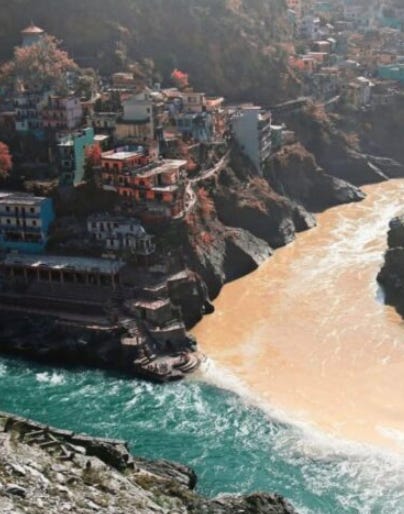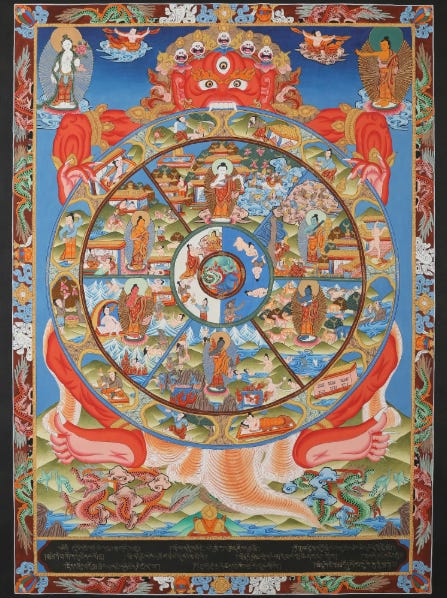Darshanim: a story-teller
“A Parable is made to purify and illuminate the mortal human heart.” - Adi Da
This post is an introduction to myself and the stories and parables I share . . .
To paraphrase the ancient Greek writer Thucydides:
“All that I have written are not essays to win the moment's applause but to mark a path for all time.”
Let me tell you a story . . .
Sevagram, Maharashtra, India, 2004. This picture was taken during my time at Kalidas Sanskrit University, where I received a degree in Ayurveda. While there, I visited the Sevagram Ashram (Village of Service) of Mahatma Gandhi.
In the Jewish tradition, a person who ‘tells stories about stories in the Torah’ is called a Darshanim. His own ‘story about a story in the Torah’ was called a Midrash, or a Midrash Haggadah (parable or anecdote). Such a person interpreted biblical narratives and ideas, was an explorer of ethics and theology, and a creator of homilies and parables based on biblical texts.
I thought I might be a Darshanim since I first heard the word, and I have always considered my writings to be a Midrash.
"There were wandering Darshanim who traveled from one town to another, often because of persecution or adverse economic conditions rather than by invitation. Thus, the visiting Darshanim had to apologize with much humor, self-deprecation, and flowery expressions to gain the sympathy of the congregation, especially the local Hakimim (wise men)."From: The Apology of the Preacher, by Abn Allah Ben Saber, 1650
Consider this my ‘apology’ . . . .
I have never exclusively focused on the Teachings said to be given to Moses by Yahweh at Mount Sinai (the Torah), instead, I swim in that great ocean, of the now gathered together in the same room of our consideration for the first time in history, the Great Traditions of Religion and Spirituality. They are my Torah, and I spin like a wheel around their hub.
I am a religious studies scholar and have studied the Talmud (the compilation of religious wisdom), not merely of Jewish believers, philosophers, and enthusiasts, but those of the Realized Teachers of the world, those who know by experience of what they speak, those who became One with the God or Reality of their beliefs.
I have been interested in religious traditions since I was a little boy. I read the great commentators and teachers, but I fell in love with the Realizers, Saints, Sages, Siddhas, the 'Crazy Wise' men and women of the world. These were not 'pipe-smoking philosophers'; the lives they lived and the stories they told revealed the constant Miracle, the mysterious Infinity of everything, their non-preference regarding all conditions, and the humor of everyday living.
They embodied what they spoke of. The tales they told were Radical and went to the root. Their Presence, Acts, and Teachings in the world changed my life and the lives of others.
As for myself, along with what I thought was a spiritual practice, I tasted everything: business, relationships, money, food, sexuality, possessions. Like an explorer, I indulged, visiting exotic people, places, customs, and practices, adventuring in foreign lands and practices, and like everything I experienced, it did not make a difference . . .
Here are some of the 'jewels' I carried back: Here are a few stories to share what I found, here is my Midrash Haggadah . . . the tales and essays of experiences I have had and ideas I have come across, people I have met, sights I have seen and mistakes I made. I am overwhelmed with gratitude for the winds of grace that filled and still fill my sails.
I had just bathed in the Ganges at Vasishtha Gufa and was happily miming a Kriya (spontaneous gesture of the body when filled with subtle energy) on the road that follows the Ganges above Rishikesh. This is an example of many of the road signs in northern India.
Two rivers join together at Dev Prayag, the Alakananda and the Bhagirathi. After this Divine (Dev) confluence (Prayag), these same two rivers, now one, are called the 'Ganges.'
Devprayag, approximately 1.5 hours up the Ganges from Rishikesh. Here, the Alakananda and Bhagirathi Rivers flow together. From the confluence of these two rivers, these waters are called the Ganges.
I walked the banks of the rivers of renunciation and indulgence. I bathed in both of them, and neither made any difference.
Now, they have joined together in the Ganges of my own life. I dip my toes in this River of Heaven and imagine its source and flow; in all its variations, it always tastes the same.
Once, I heard and read about the River of Heaven; over and over, I visited and bathed in its waters. But, as Kabir once said:
“If bathing in the Ganges brought salvation, then every fish is in heaven”
I have met a few extraordinary teachers and One Unbounded as the sky. For all of this, I am overwhelmingly thankful, but I am still an ass, bearing a load of books, weighed down with experiences, memories, exquisite and assorted tales. Also, here are a few of the stories that are not my own, I found etched on rocks along the banks of the River of Heaven . . .
And now, let me offer a closing apology to the wise men and women of my time: We all make mistakes, but not all mistakes are necessary. Therefore, I am obligated to share what I have seen, what I learned, the mistakes I made, the trail I traveled, and the dead ends I found. 'Dead ends' marked the beginning of Wisdom for me, and if you are fortunate, you will discover your own . . .
Until then, perhaps we will meet for a moment on the Wheel of Time . . .
The Bhavachakra or ‘Wheel of Life:
This picture is painted on the wall at the right-hand side of the entrance passage to every Tibetan Buddhist monastery. It is a condensed summary of the Buddha's Teachings, expressed in visual form. Having visited several ancient monasteries on the Tibetan Plateau, it was obvious that in a preliterate culture, the transmission of Buddhist Teachings to the masses needed to be expressed in ways that were not textual. The Wheel of Life is one such expression.
It is a wheel illustrating the manifestation of the ever-changing nature of life, encompassing the rising and falling, coming and going stages of birth, youth, marriage, old age, death, and reincarnation. Rising to heaven because of good karmas, and when those karmas are exhausted, falling to the lower realms, the results of this ever-changing nature and its always present and co-dependent opposites. Centered in the ‘hub’ of this wheel is a pig (ignorance), a rooster (attachment/desire), and a snake(aversion) biting each other’s tails. These represent the ‘three poisons’ which drive the cycle of rebirth and suffering. These are the essential obstacles to enlightenment.
Wheel of Life (Center Image)
This wheel is held by Kala or Time, the demon crowned with the five skulls representing the five elements of which creation exists. Kala or Time also has three eyes, which represent the present, past, and the future. In the upper right and left-hand corners of the image, outside the Wheel, stand two manifestations of the Buddha, symbols of Liberation from the Wheel of Suffering. In the image above, Buddhas are also shown in every section of the Wheel (not all images do this). They represent the Teaching of the Buddhas in every stage and aspect of life.








